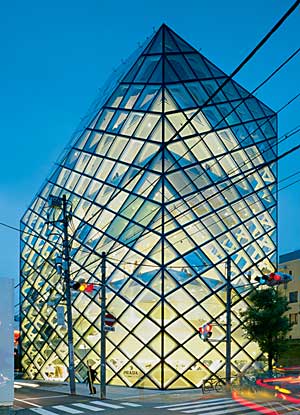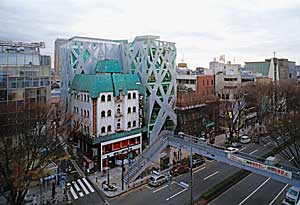The cherry blossoms were at their peak on a Thursday in late March when I went for a stroll in Ueno Park in Tokyo. A nimbus of white glowing pink with dramatic dark branches etched through it floated above the crowds strolling, photographing, and picnicking on blue tarps spread beneath the trees. What could be more Japanese than such civic reverence for this short-lived phenomenon in all its tender aesthetic frailty? Of course, everyone’s behavior was exemplary, not a scrap of litter and no one disrespecting the pedestrian flow.


Tokyo is a shrine to convulsive order, at once chaotic and fastidious. The density of graphic information, of building, of infrastructure, of people, of circumstances is like nowhere else on earth. It is a city constantly reconfigured by juxtaposition and remarkable in its tolerance of diversity in scale. (How does the market allow this, I wonder?) All over the city, small structures jostle with midsize and large ones in a counterpoise of energy and repose. It’s an enduringly fabulous place and the mingling of tradition, originality, and money has made it a center for design. This sensibility extends from the postwar generation of Japanese Modernists to the current day, and no country has produced a more refined and innovative cohort of practitioners or an environment more hospitable to contributions from abroad, a place at once insular and open.
For the architectural tourist, the epicenter of attraction these days is a street called Omotesando and the neighborhood around it. The street itself is unusual for Tokyo: Broad and bowered by elegant zelkova trees, it slopes at a mild but palpable incline, enlivening section and experience. Sidewalks are wide and conducive to promenading and offer an opportune arena for a parade of youth-culture fashionability. After the heterogeneous crowd at Ueno, the more homogeneous—if totally fashion-forward—scene on Omotesando is striking. Surely, Japanese kids are as meticulously put together as any on the planet, and the style of the day is exquisite, at once recombinant and singular. The kids on the street in their raffish, sexy, distressed, vaguely aggressive but ultimately conformist getup challenge the salary-man uniformity of black suits that sets the adult-world tone while reproducing its assumptions. In both cases, precision matters, as it always has with Japanese culture and architecture.
A seething rhapsody
Kids have red hair blown big, low-riding jeans, and zooty watch chains, a uniform slouch of nonchalance and languid gait, tiny skirts and short shorts (pockets dangling out below the hem) with knee-high stockings, endless variations on the tarty school-girl look, four and five layers of clothing in a range of overlapping lengths, filmy, gauzy skirts topped by thick leather jackets worn with tough boots, studs galore (if not so many visible tattoos), shades and specs perched on the head—a seething rhapsody of uniform insubordination. Omotesando is a spot to preen, to study, to practice style solidarity, and to shop.
The famous-architect-designed buildings that line Omotesando are almost all name-brand, upmarket shops and the street is both a collection of the architecture of boutiques and a boutique for architecture. Here the brands gather: Prada, Vuitton, Tod’s, Dior, Chanel, Bulgari, Dolce, MoMA, Lauren, Vuitton, Fendi, Celine, Fcuk (not to mention McDonald’s, Starbucks, and Sharkey’s Pizza). And here, too, the leading brands of contemporary architecture: Ando, Ito, Sejima, Kurokawa, Aoki, Maki, Herzog & de Meuron, Kuma, and Tange. The corroborating symmetries between the goods and their packaging are dense and speak volumes about the contemporary deployment of style—its utility as advertisement and value enhancer, and its assertive enforcement of the permanent elision of culture and consumption.
On Omotesando, the loop between architecture, shopping, and the subjects who buy into it is hermetic and complete.
I found the place at once a cause for celebration and for depression, as well as a good spot to reflect on the way in which architecture accretes its meanings. Here are buildings that reflect the profession at its best, most inventive, and most artistic. The remarkable collection richly addresses so many issues that are native to all architecture: the play of light and shade, opacity and density, the expressive meaning of structure, the logic of geometry, the nature of materiality, the tectonics of gravity, the flow of space, the meaning of scale, the limits of meaningful adjacency, the intertwining of form and function. What fun! What inspiration! What detailing!
But as much as I was dazzled by the assembly of talent, this orgy of superluxe selling soon started some synapse flashing the word Darfur in my brain with increasing and annoying frequency. Ah, the sanctimonious prig in me spoiling my pleasure once again.
I grew mildly agitated between sips of cappuccino. What does all this superlativeness owe the rest of the earth, if anything? Nowadays we often dispatch our political responsibilities through the medium of environmental action, and this is surely most important. But these buildings seemed tenacious in taking not the slightest cognizance of green issues. Sealed up in perfectly gasketed glass and slathered in the finest finishes, this gathering—in its own conformity of indifference—certified the amazingly AWOL behavior of our stars to architecture’s social side and our own complicity in promoting this narrowed meaning of form. Somewhere, I blundered across a Patagonia store with its advertisement: “1 Percent For The Planet.” That about sums it up.


Post a comment to this article
Report Abusive Comment